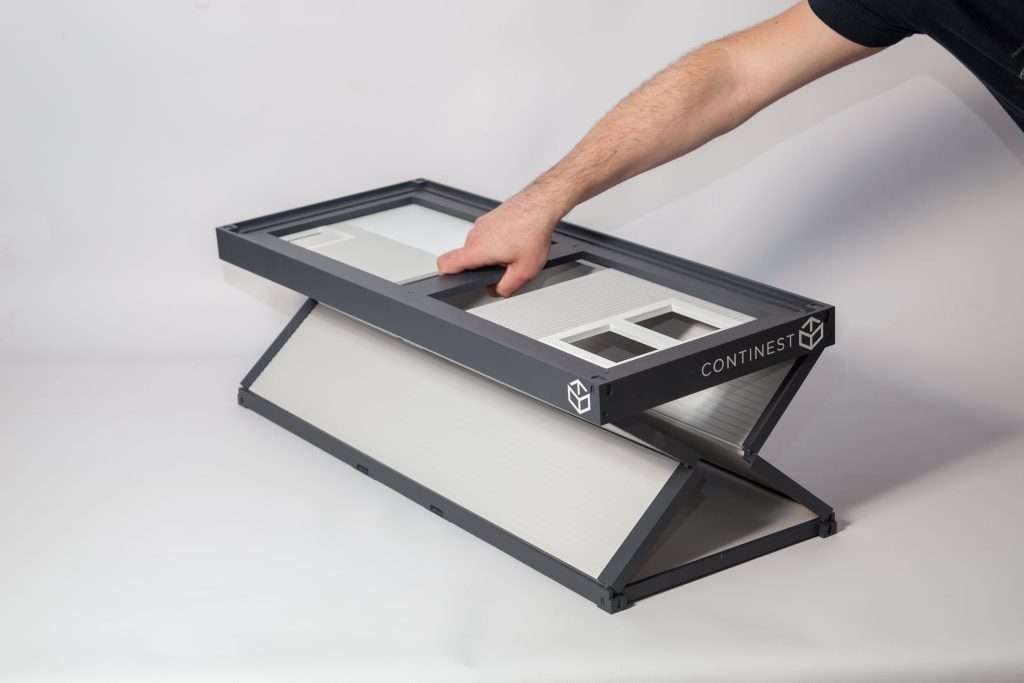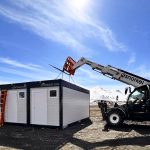Modular construction is rapidly changing how we think about building — making it faster, more sustainable, and more adaptable to different environments. Among the most innovative solutions in the space are foldable container designs, which allow for compact transport, quick setup, and flexible reconfiguration. Whether you’re planning a large-scale event, building temporary housing, or creating mobile workspaces, understanding the potential of modular container buildings is key to making informed decisions.
Why Modular Buildings Are on the Rise
Global demand for modular building solutions is surging for three main reasons:
- Speed of deployment – In an era where projects often need to be operational in weeks rather than months, traditional construction simply can’t keep up.
- Cost efficiency – Factory-built structures reduce labor costs, minimize material waste, and allow more predictable budgeting.
- Flexibility – Structures can be reconfigured, relocated, or scaled up and down to meet evolving needs.
Speed of Deployment: Meeting Urgent Needs in Record Time
In an era where projects often need to be operational in days or weeks rather than months, traditional construction methods simply can’t keep pace. This is especially critical in natural disaster relief, where speed can mean the difference between adequate shelter and prolonged displacement. After hurricanes, wildfires, or earthquakes, communities need safe, reliable housing — and they need it fast. Continest’s foldable container technology allows entire villages of housing units to be deployed in hours, not months. Units arrive compact, unfold in minutes, and are ready for use almost immediately, ensuring help gets where it’s needed when it’s needed most.
Cost Efficiency: Smarter Builds, Better Budgets
Factory-built structures offer multiple layers of cost savings that traditional construction can’t match:
- Minimal material waste – Controlled manufacturing ensures precise use of materials, reducing scrap and excess waste that would otherwise end up in landfills.
- Reduced labor costs – Since Continest units are pre-fabricated in a controlled environment, on-site assembly takes minimal manpower. A small crew can deploy dozens of units in a fraction of the time of conventional builds.
- Predictable budgeting – With the majority of costs determined before the units leave the factory, clients avoid the common cost overruns associated with unpredictable weather delays, supply chain issues, or fluctuating labor expenses.
The result? Lower total project costs, without compromising on quality or safety.
Flexibility: Infrastructure That Moves With You
Continest’s modular building solutions are designed for change. Units can be reconfigured, relocated, or scaled to meet evolving needs. This flexibility is invaluable for projects where demands shift quickly — whether that’s expanding a temporary hospital during a health crisis, adjusting event layouts for crowd control, or relocating retail units to new venues.
And it’s not just about functionality — custom branding and design are also part of the package. Units can be wrapped or painted to align with event themes, sponsor logos, or organizational colors, transforming functional infrastructure into an integrated part of the experience.
For governments, aid organizations, and private companies, this combination of speed, cost savings, and adaptability is reshaping the built environment.
What Are Modular Buildings?
In simple terms, modular buildings are structures constructed off-site in modules (or sections) before being transported and assembled on location. This process offers greater quality control because most of the work happens in a factory environment with precise engineering standards.
Foldable containers take this concept a step further: their walls collapse inward for transport, allowing multiple units to be stacked and shipped on a single truck or container vessel — drastically reducing logistics costs and environmental impact.
How Foldable Containers Work
A foldable container typically consists of:
- Structural steel frame – Provides strength and stability to withstand transport and repeated assembly.
- Insulated wall panels – Improve thermal efficiency and soundproofing.
- Integrated flooring systems – Often made from reinforced steel and durable finishes to withstand heavy use.
- Pre-installed utilities – Electrical wiring, lighting, and sometimes plumbing are built in at the factory.
The engineering allows a single unit to be unfolded and secured in 5–10 minutes, compared to hours or days for other temporary infrastructure solutions.
Key Benefits of Modular Container Buildings
Rapid Deployment: Ready in Minutes, Anywhere
When disaster strikes or a large-scale event is approaching, time is the most valuable resource. Continest units can be set up in as little as five minutes per container, even in challenging environments like remote disaster zones, construction sites, or high-traffic event grounds. The design eliminates complex assembly steps, meaning less reliance on heavy equipment and fewer workers on-site. This speed ensures that critical services — from housing and medical facilities to security offices — can be operational almost immediately.
Scalable Configurations: From Single Units to Complex Infrastructure
Whether the need is a single concession stand or a multi-story operations hub, Continest’s modular container buildings can be combined into double wides, triple wides, and even stacked to create multi-level complexes. This scalability allows organizations to start small and expand as needed, without committing to permanent construction. For example, a temporary medical camp could begin with a handful of patient care units and later grow into a fully functioning field hospital — all using the same modular system.
Transport Efficiency: More in Every Mile
Traditional modular units often require multiple trips to deliver even a small village of buildings. Continest’s foldable design changes the game — up to 10 units can fit on a single 40-foot flatbed truck, compared to just two traditional containers. This drastically reduces transportation time, costs, and coordination headaches, especially for international deployments or projects in remote locations.
Lower Environmental Impact: Less Waste, Lower Emissions
By maximizing transport efficiency, Continest reduces CO₂ emissions by up to 80% compared to other modular building providers. The foldable design also limits the need for excessive trucking and shipping. On-site, the controlled factory build means less material waste, no need for large debris disposal, and minimal ground disturbance. For clients prioritizing sustainability — whether for ESG goals, environmental certifications, or public relations — these benefits are both measurable and meaningful.
Durability and Safety: Built for the Real World
Continest units are designed to meet modular certification and strict safety standards, ensuring they’re not just fast and flexible but also reliable. Built from state-of-the-art materials, these structures can withstand demanding climates, heavy use, and repeated deployments without compromising structural integrity. From harsh winter conditions at mountain sports events to the humid, tropical environments of island deployments, Continest containers hold up where others fail.
Applications Across Industries
The adaptability of modular infrastructure makes it valuable in a wide range of scenarios:
- Disaster Relief – Deploy housing, medical clinics, and operations centers in days instead of weeks.
- Event Operations – Create retail spaces, broadcast booths, and hospitality suites for major sporting events.
- Military & Defense – Provide secure command posts, barracks, and medical facilities that can be moved as needed.
- Education – Add temporary classrooms to meet sudden enrollment spikes.
- Remote Worksites – Equip oil fields, mining sites, or research stations with on-demand infrastructure.
Sustainability Advantages
While speed and cost are major selling points, the environmental benefits of foldable containers are equally important. These include:
- Reduced transport emissions – Moving more units per trip means fewer trucks on the road and less fuel consumed.
- Reusability – Units are designed for repeated assembly and disassembly without material degradation.
- Lower site disturbance – Minimal excavation or permanent alteration to the land compared to traditional builds.
- Waste reduction – Factory fabrication minimizes offcuts and scrap materials.
Challenges to Consider
Even with clear benefits, modular container buildings may not be right for every situation. Factors to weigh include:
- Zoning and permitting – Some municipalities require additional approvals for temporary infrastructure.
- Customization limits – While highly adaptable, there are constraints compared to fully bespoke architectural builds.
- Upfront logistics planning – Transport, site prep, and sequencing still require careful coordination.
The Future of Modular Infrastructure
With increasing demand for rapid, sustainable, and mobile infrastructure, innovations in foldable container design will continue. Expect to see:
- Improved insulation and energy efficiency – Enhancing comfort in extreme climates.
- Integrated renewable energy – Solar panels and battery storage becoming standard options.
- Smarter deployment systems – Automation and AI-assisted site planning to further cut setup time.
FAQs
What are modular buildings and how do they work?
They are pre-fabricated structures built off-site, transported in sections or folded down, and assembled on location. This reduces build time and increases quality control.
Are foldable container homes safe and durable?
Yes. They are engineered to meet modular safety certifications and withstand repeated assembly and relocation.
How fast can modular buildings be installed?
A single foldable unit can be deployed in 5–10 minutes. Multi-unit complexes may take a few hours to a couple of days, depending on size and utility connections.
What is the difference between modular and traditional construction?
Modular construction happens off-site in controlled environments, leading to faster, cleaner builds with less waste. Traditional construction builds on-site from the ground up.
How are foldable containers transported and set up?
Units are stacked flat for shipping — up to 10 per truck — then unfolded and secured on-site with minimal labor and no heavy machinery in many cases.
Conclusion: Why Continest Is Leading the Foldable Modular Revolution
From large-scale events to disaster relief operations, the need for modular building solutions that are fast, sustainable, and adaptable has never been greater. Continest’s foldable container technology directly addresses these challenges — delivering temporary infrastructure that’s not only rapid to deploy but also significantly reduces environmental impact.
By transporting up to 10 units per truckload, our CN units cut transportation emissions by up to 80% compared to traditional methods. The ability to deploy in minutes means less downtime, fewer on-site labor requirements, and more immediate results for our partners. And because every unit is reusable, relocatable, and built to last, Continest provides an infrastructure solution that doesn’t just solve today’s needs, but can be reconfigured for tomorrow’s demands.
Whether it’s serving fans at major sporting events, creating operational hubs for emergency response, or supporting remote worksites, Continest offers a smarter, greener way to build. With us, you don’t have to choose between speed, flexibility, and responsibility — you can have it all.




